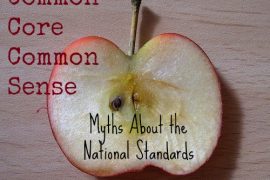In recent months, there’s been a tremendous amount of buzz regarding an educational change called Common Core. And a ton of that buzz perpetuates down-right false information. There’s so much to say about this that I’ve developed a five-part series debunking these myths — or outright lies, if you’re being cynical. This is the last post of that series (read Myth 1, Myth 2, Myth 3 and Myth 4), which began in August. Of course, I’m writing from a math perspective. Photo Credit: Watt_Dabney via Compfight cc
Myth #5: Common Core is Overflowing with Fuzzy Math
First, a definition: fuzzy math is a derogatory term for an educational movement called reform math. Therefore the claim of fuzzy math isn’t so much a myth as an attempt to insult the way that many math teachers and education researchers advocate teaching mathematics to K-12 students.
Second, some history: in 1989, the National Council of Teachers of Mathematics (disclaimer: I was once a member) published a document called Curriculum and Evaluation Standards for School Mathematics, which recommended a newish philosophy of math education. The group followed with Principles and Standards for School Mathematics in 2000. School officials and curriculum companies responded by implementing many of the approaches offered by the NCTM and as a result, the way we teach mathematics began to change. This change is what advocates call reform math and critics often call fuzzy math.
Before the NCTM’s publications, math teachers focused on the math — in particular series of steps (algorithms) designed to get the right answer to a problem or question. With reform math, educators became more focused on how students best learn mathematics. Suddenly, context and nuance and “why?” were at least as important as the answer. And it is true that Common Core Standards for Mathematics are largely based on the NCTM’s publications.
If this is truly fuzzy math, then we don’t have a myth here. (Although, to be fair, there is a legitimate branch of set theory and logic called “fuzzy mathematics.” But somehow, I don’t think Common Core critics using this term have real math in mind.) I include the fuzzy-math criticism as a myth because it suggests that teaching math in a conceptual way is a bad idea.
Throughout this series, I have asserted that the best way for students to understand and remember mathematical concepts is by returning over and over to the concepts behind the applications. Why is 24 such a flexible number? Because it has eight factors: 1, 2, 3, 4, 6, 8, 12 and 24. Students who really get this will have an easier time adding and subtracting fractions, reducing fractions, simplifying algebraic expressions and eventually solving algebraic equations through factoring.
This is numeracy, folks.
Students will not become numerate (think literate but with math) without a solid, conceptual understanding of mathematical ideas and properties. Numeracy does not typically evolve from memorizing multiplication tables or long division or pages and pages of practice problems. (Disclaimer: some kids will certainly become numerate regardless of how they’re being taught, but many, many others won’t.)
Numeracy is a life-long quest concentrated between the ages of five and 18 years old. Grownups can gain numeracy, but isn’t it better for our kids to enter into adulthood with this great understanding?
If Common Core critics want to call this whole philosophy “fuzzy math,” so be it. Just know that the ideas behind reform mathematics are deeply rooted in research about how kids learn math, not some ridiculous idea that was made up in the board rooms of a curriculum development company or smoke-filled political back rooms.
In short, the problems with Common Core math are not found in the standards themselves. Instead, the application and heated discourse are clouding Common Core’s real value and promise.
Got a question about the Common Core Standards for Mathematics? Please ask! Disagree with my assessment above? Share it! And if you missed Myth #1, Myth #2, Myth #3, Myth #4, you can find them here, here, here and here.
